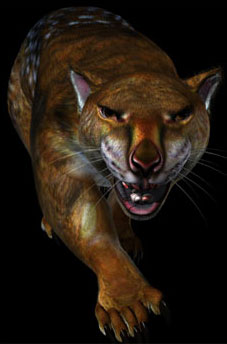Humans – not climate – drove extinction of giant Tasmanian animals
Humans – not climate – drove extinction of giant Tasmanian animals
mongabay.com
August 11, 2008
|
|
Humans — not climate change — were responsible for the mass extinction of Australia’s megafauna, according to a new study published this week in the journal Proceedings of the National Academy of Sciences.
Dating fossil remains on the Australian island of Tasmania, a team of researchers found evidence that island’s large animals died out only after the arrival of human settlers some 43,000 years ago, thereby implicating humans as the likely trigger for the demise of Tasmania’s giant kangaroos and marsupial ‘rhinos’ and ‘leopards’. Previously some scientists argued that Tasmania’s megafauna went extinct before the emergence of a land bridge that linked the island to mainland Australia.
 Computer generated graphic showing what Thylacoleo may have looked like. Image courtesy of the Western Australian Museum. |
“Ever since Charles Darwin’s discovery of giant ground sloth remains in South America, debate has ensued about the cause of early extinction of the world’s megafauna,” said lead author Chris Turney of the University of Exeter. “Now, 150 years on from the publication of Darwin’s seminal work The Origin of Species, the argument for climate change being the cause of this mass extinction has been seriously undermined. It is sad to know that our ancestors played such a major role in the extinction of these species — and sadder still when we consider that this trend continues today.”
Earlier research by study co-authors Tim Flannery of Macquarie University and Bert Roberts of the University of Wollongong has shown that 90 percent of mainland Australia’s megafauna disappeared about 46,000 years ago, shortly after humans first settled the continent. Humans didn’t reach Tasmania until 43,000 years ago when lower sea levels due to glaciation allowed them to walk from the mainland.
“The Tasmanian results echo those on mainland Australia, putting humans squarely back in the frame as the driving force behind megafaunal extinction”, Roberts explained.
The authors say that lack of evidence for a major change in vegetation or fire dynamics — unlike on the mainland — suggests that “human hunting led to a rapid population collapse.”
Counted among Tasmania’s victims are Zygomaturus trilobus, a rhino-like marsupial that weighed up to 1100 pounds (500 kg); Palorchestes azael, a marsupial similar to a ground-sloth that also weighed up to 1100 pounds (500 kg); Metasthenurus newtonae, a large, short-faced kangaroo that browsed like an antelope and weighed up to 330 pounds (150 kg); Thylacoleo carnifex, a leopard-like marsupial weighing up to 220 pounds (100 kg); and Megalibgwilia sp., a monotreme (egg-laying mammal) similar in shape and size to the long-beaked echidna of New Guinea and weighing around 22 pounds (10 kg).
The Tasmanian devil — the largest predator surviving on the island — is facing a severe threat from the outbreak of a contagious facial cancer.
Chris S. M. Turney et al (2008). Late-surviving megafauna in Tasmania, Australia, implicate human involvement in their extinction. PNAS Online Early Edition for the week of August 11-15, 2008.
Related
Giant carnivorous marsupial beasts not killed by climate change
Evidence points towards human origin of Australian megafauna extinction January 25, 2007
Humans, not climate change, caused the extinction of megafauna in Australia contends a team of Australian researchers writing in the January issue of the journal Science.